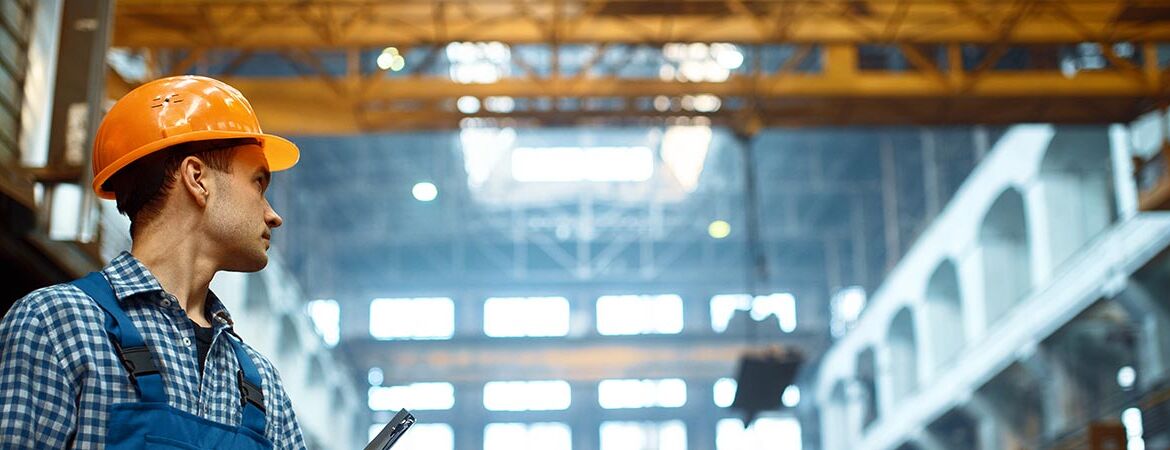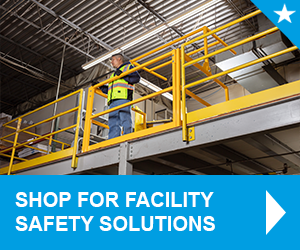
From dangerous machinery to toxic chemicals, industrial facilities have numerous safety risks to manage. At the top of that list is any potential fall hazard, even those at lower heights or involving only brief activity. This could include more obvious elevated areas within your facility, such as mezzanines, but also small ledges, surface gaps, and hard-to-spot transitions.
Here we’ve compiled the most frequently asked questions about indoor fall hazards and working-at-height safety. We’ll also describe the appropriate OSHA compliant fall protection systems for each issue, enabling industry professionals to efficiently improve their interior industrial fall safety and ensure a safer workforce.
The Most Common Industrial Fall Hazard Questions
1.) What Are the Most Common Indoor Fall Hazards?
Common indoor fall hazards include:
- Unprotected leading edges
- Stairways
- Fixed ladders
- Loading docks.
- Mezzanines and catwalks
- Slippery or wet surfaces, such as spills or recently mopped floors
- Uneven or damaged flooring, including loose tiles, torn carpeting, or uneven thresholds
- Cluttered walkways and obstructed pathways, such as when cables, cords, or objects are left in high-traffic areas
- Poor lighting conditions that make it difficult to see potential hazards or changes in floor surfaces
Safety managers would benefit from completing routine checks on their facilities to ensure that there are no hazards that are easily avoidable such as loose tiles or obstructed pathways. For other common hazards that are not as easily avoidable, such as a leading edge, the installation of modular safety rails with a safety gate will help to keep those working at any height safe. Just as a facility should maintain its property with routine cleaning, it is just as important for them to have OSHA compliant fall protection to keep employees working safe and efficiently.
2.) When Do Stairways Require Fall Protection?
Always. They’re one of the most common sites of industrial worker falls, and minimum stairway requirements include:
- A smooth, snag-free handrail between 30″ and 37″ high, with properly spaced midrails.
- Modular safety rails on any unprotected side
- Slip-free surfaces
- No protrusions or projection hazards
- Stair angles built 30–50° from horizontal
Safety gates are not always required but are generally recommended for stairways and permanent ladders (such as for roof access). Besides protecting workers from accidental falls down a stair or ladderway, safety gates provide employees an opportunity to pause and assess their surroundings before ascending or descending, and it reduces the likelihood of debris or tools accumulating near the access points. Gates must be installed to open outward and away from the stairway or ladder, and they must heed certain dimension limits proportional to the structure the steps lead to.
3.) What Are the Main Causes of Indoor Falls?
The main causes of indoor falls include:
- Slips: When there is a loss of traction between the foot and the walking surface, often due to slippery or wet conditions.
- Trips: When a person’s foot collides with an object or uneven surface, causing them to lose balance and fall.
- Missteps: Taking an incorrect step due to poor visibility, distractions, or unfamiliarity with the surroundings.
- Poor balance or physical impairments: Factors such as age, health conditions, and wearing inappropriate footwear can increase the risk of falls.
- Lack of awareness: Failing to notice or address hazards, such as uneven surfaces or cluttered walkways, can lead to falls.
In the case of a slip, trip, or misstep, there are a few things that a facility can implement to reduce the risk of serious injury. If a worker was to slip in an area where heavy machinery is present, they may run the risk of falling into said machinery. By installing a modular rail for machinery, the risk of injury decreases. If a slip is inevitable, such as in places where oil, grease, or water are always present, it is at the least very important to ensure workers won’t be injured if they fall into machinery.
4.) What’s the Best Way to Keep Loading Docks Safe Without Interfering with Workflow?
Loading docks require several consistent elements for safe and effective workflow to minimize the risk hazards for workers, including:
- Ample space
- Installation of loading dock safety gates
- Unobstructed sightlines
- Elimination of trip hazards
If floor space is an issue, loading dock gates with a vertical-lift design are an effective solution. And loading dock gates with a dual vertical-lift setup maximize space usage even further, reducing interference both vertically and laterally. These gates are an appropriate solution when space is limited in all directions, making a single vertical-lift gate impossible and rendering swinging gates a waste of valuable floor space.
Loading docks that extend outward into the bay will also need modular safety rails to ensure workers move safely between the truck and the warehouse.
5.) Can Fall Protection Products Also Protect Site Equipment?
Absolutely. While maintaining worker safety is job number one, a falling employee can also damage valuable equipment. Whether a fall occurs from the side of the equipment or an elevated position, your machinery can be protected with the same solution.
A modular rail for machinery is a common way to ensure employees don’t fall onto fabrication, manufacturing, or other industrial equipment. It also functions as a travel restraint system to ensure forklifts and other movable machinery are kept at a safe distance from the equipment. In fast-paced environments, workers are often moving quickly to effectively maintain their deadlines. As we previously discussed, the risk of slips, trips, and falls increases in these scenarios, so keeping workers safe from potentially falling into site equipment with the use of a modular rail for machinery is crucial.
- Are There Specific Regulations or Standards Regarding Indoor Fall Protection?
Regulations and standards related to indoor fall protection may vary depending on the country or region. In the United States, for example, OSHA sets standards related to workplace safety, including fall protection. Employers are responsible for complying with OSHA regulations, which often include requirements for providing a safe working environment, conducting hazard assessments, implementing safety measures, and providing appropriate training for employees. It is important to consult local regulatory agencies and industry-specific guidelines to ensure compliance with relevant standards.
Fabenco FAQ
Our broader FAQ answers some of the most general questions about selecting the right OSHA compliant fall protection systems, and we encourage you to contact us with any further fall hazard questions you might have. Our fall protection experts are standing by to help you determine which safety products are suitable for your needs, and our design engineers are fully capable of custom-fabricated solutions and special orders.





